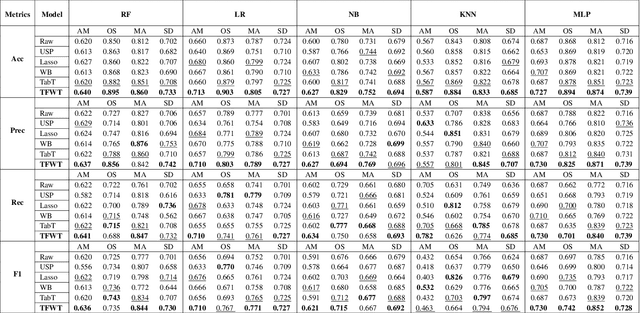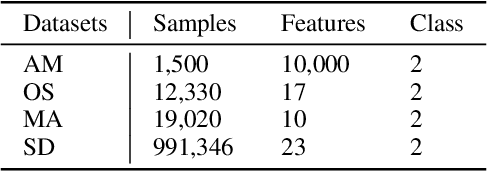Wanfu Gao
Collaboration and Controversy Among Experts: Rumor Early Detection by Tuning a Comment Generator
Apr 05, 2025Abstract:Over the past decade, social media platforms have been key in spreading rumors, leading to significant negative impacts. To counter this, the community has developed various Rumor Detection (RD) algorithms to automatically identify them using user comments as evidence. However, these RD methods often fail in the early stages of rumor propagation when only limited user comments are available, leading the community to focus on a more challenging topic named Rumor Early Detection (RED). Typically, existing RED methods learn from limited semantics in early comments. However, our preliminary experiment reveals that the RED models always perform best when the number of training and test comments is consistent and extensive. This inspires us to address the RED issue by generating more human-like comments to support this hypothesis. To implement this idea, we tune a comment generator by simulating expert collaboration and controversy and propose a new RED framework named CAMERED. Specifically, we integrate a mixture-of-expert structure into a generative language model and present a novel routing network for expert collaboration. Additionally, we synthesize a knowledgeable dataset and design an adversarial learning strategy to align the style of generated comments with real-world comments. We further integrate generated and original comments with a mutual controversy fusion module. Experimental results show that CAMERED outperforms state-of-the-art RED baseline models and generation methods, demonstrating its effectiveness.
Entropy-based Exploration Conduction for Multi-step Reasoning
Mar 20, 2025Abstract:In large language model (LLM) reasoning, multi-step processes have proven effective for solving complex tasks. However, the depth of exploration can significantly affect the reasoning performance. Existing methods to automatically decide the depth often bring high costs and lack flexibility, and thus undermine the model's reasoning accuracy. To address these issues, we propose Entropy-based Exploration Depth Conduction (Entro-duction), a novel method that dynamically adjusts the exploration depth during multi-step reasoning by monitoring LLM's output entropy and variance entropy. We employ these two metrics to capture the model's current uncertainty and the fluctuation of uncertainty across consecutive reasoning steps. Based on the observed changes, the LLM selects whether to deepen, expand or stop exploration according to the probability. In this way, we balance the reasoning accuracy and exploration effectiveness. Experimental results across four benchmark datasets demonstrate the efficacy of Entro-duction. We further conduct experiments and analysis on the components of Entro-duction to discuss their contributions to reasoning performance.
Uncertainty-Aware Global-View Reconstruction for Multi-View Multi-Label Feature Selection
Mar 18, 2025Abstract:In recent years, multi-view multi-label learning (MVML) has gained popularity due to its close resemblance to real-world scenarios. However, the challenge of selecting informative features to ensure both performance and efficiency remains a significant question in MVML. Existing methods often extract information separately from the consistency part and the complementary part, which may result in noise due to unclear segmentation. In this paper, we propose a unified model constructed from the perspective of global-view reconstruction. Additionally, while feature selection methods can discern the importance of features, they typically overlook the uncertainty of samples, which is prevalent in realistic scenarios. To address this, we incorporate the perception of sample uncertainty during the reconstruction process to enhance trustworthiness. Thus, the global-view is reconstructed through the graph structure between samples, sample confidence, and the view relationship. The accurate mapping is established between the reconstructed view and the label matrix. Experimental results demonstrate the superior performance of our method on multi-view datasets.
Reconsidering Feature Structure Information and Latent Space Alignment in Partial Multi-label Feature Selection
Mar 13, 2025Abstract:The purpose of partial multi-label feature selection is to select the most representative feature subset, where the data comes from partial multi-label datasets that have label ambiguity issues. For label disambiguation, previous methods mainly focus on utilizing the information inside the labels and the relationship between the labels and features. However, the information existing in the feature space is rarely considered, especially in partial multi-label scenarios where the noises is considered to be concentrated in the label space while the feature information is correct. This paper proposes a method based on latent space alignment, which uses the information mined in feature space to disambiguate in latent space through the structural consistency between labels and features. In addition, previous methods overestimate the consistency of features and labels in the latent space after convergence. We comprehensively consider the similarity of latent space projections to feature space and label space, and propose new feature selection term. This method also significantly improves the positive label identification ability of the selected features. Comprehensive experiments demonstrate the superiority of the proposed method.
TFWT: Tabular Feature Weighting with Transformer
May 17, 2024



Abstract:In this paper, we propose a novel feature weighting method to address the limitation of existing feature processing methods for tabular data. Typically the existing methods assume equal importance across all samples and features in one dataset. This simplified processing methods overlook the unique contributions of each feature, and thus may miss important feature information. As a result, it leads to suboptimal performance in complex datasets with rich features. To address this problem, we introduce Tabular Feature Weighting with Transformer, a novel feature weighting approach for tabular data. Our method adopts Transformer to capture complex feature dependencies and contextually assign appropriate weights to discrete and continuous features. Besides, we employ a reinforcement learning strategy to further fine-tune the weighting process. Our extensive experimental results across various real-world datasets and diverse downstream tasks show the effectiveness of TFWT and highlight the potential for enhancing feature weighting in tabular data analysis.
 Add to Chrome
Add to Chrome Add to Firefox
Add to Firefox Add to Edge
Add to Edge